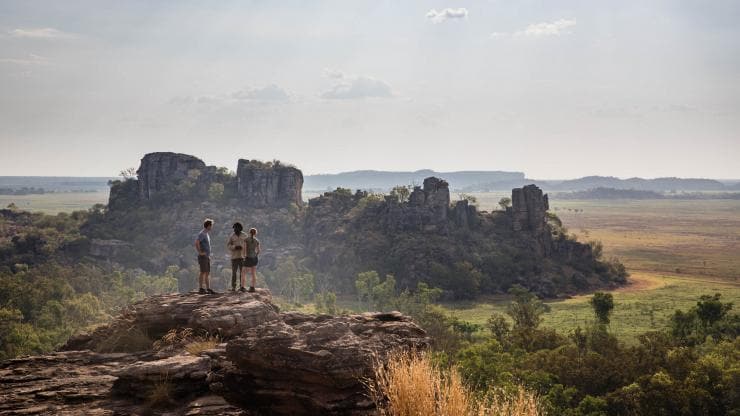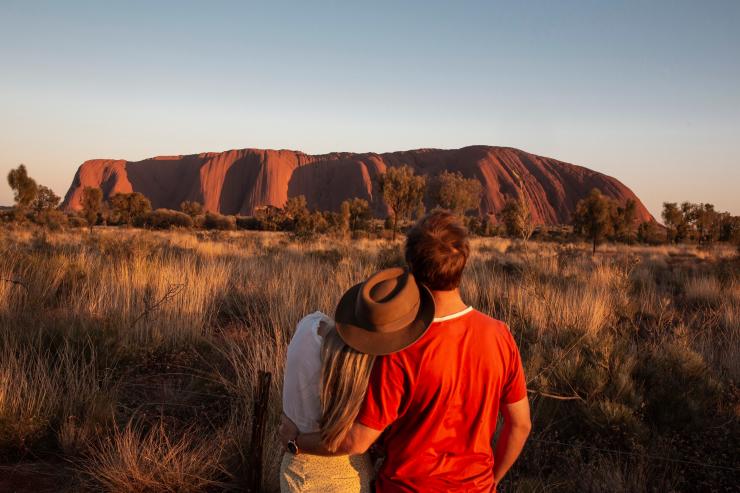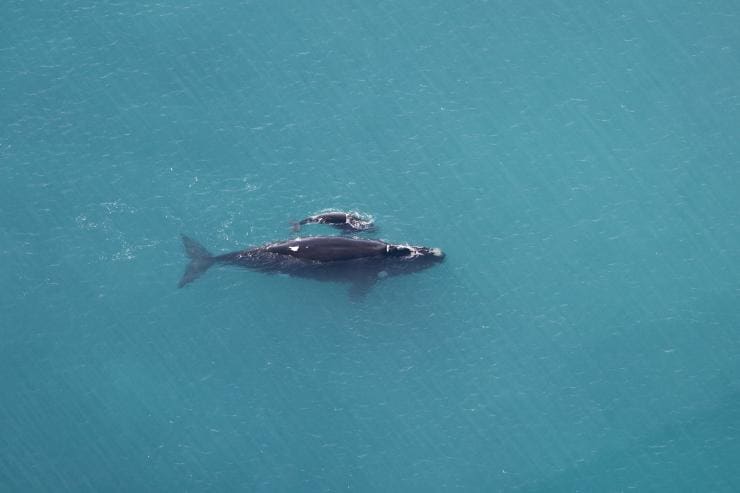
Twin Falls, Kakadu National Park, Top End, NT © Tourism Northern Territory
14 days of nature, wine and Aboriginal cultures
This 14-day adventure takes you down the centre of Australia, from Darwin to South Australia. Along the way you'll explore striking landscapes from wetlands to deserts, as well as outback towns, world-class wineries and beautiful beaches.
By Ute Junker
From the tropical north to the deserts of the Red Centre and on to the wave-washed South Australian coast, this epic journey lets you experience Australia at its most diverse. From ancient rock art in Kakadu National Park to the rugged beauty of the Flinders Ranges, and from the opal mining town of Coober Pedy (where the locals live underground) to the acclaimed wineries of the Barossa Valley, every day brings a new adventure.
What to expect
- Unforgettable natural wonders, from rugged gorges and salt lakes to iconic Uluru
- Learn firsthand about Aboriginal culture
- Taste fine food and wine in one of Australia's most acclaimed wine regions
Fast facts
- Time: 14 days
- Distance: 4,290 kilometres (2,665 miles)
- Transport: car and plane
- Nearest major city: Darwin
- Price: $$$
Day 1: Admire ancient rock art at Kakadu

Kakadu Cultural Tours, Kakadu National Park, Northern Territory © Tourism Australia
Leave Darwin in your hire car for the 2.5-hour drive to Kakadu National Park, a dramatic landscape of rugged escarpments and grassy plains. After just over two hours of driving, you will reach the scenic Mamukala Wetlands. Stretch your legs by following one of the marked trails, and keep an eye out for magpie geese and whistling ducks among the water lilies. Twenty minutes further on is the Bowali Visitors Centre, where you can purchase your visitor pass if you didn't prepay online. Take some time to view the extensive information panels and grab a bite to eat at the café before getting back on the road. From the visitors centre, it is about 30 minutes' drive to Ubirr, home to some of Kakadu’s most famous rock art and a spectacular spot to watch the sunset. In the company of predominantly Aboriginal guides, travel with Kakadu Cultural Tours beyond the main art galleries to restricted access billabongs and secret art sites, or enjoy a cruise along the overwhelmingly peaceful, lily-laden Yellow Water Billabong with Kakadu Tours. Stay overnight at Cooinda Lodge, located beneath a canopy of trees beside the billabong.
Day 2: Swim beneath a Kakadu waterfall
Kakadu's enormous waterfalls are among its most unforgettable sights. The roads leading to the most spectacular cascades, Jim Jim Falls and Twin Falls, are only accessible to 4WD vehicles. If you don’t have one, sign up for a guided tour or scenic flight. The falls are just over a one-hour drive from the hotel (Kakadu is Australia's largest national park). From the car park, the walking track to reach Jim Jim Falls is about two kilometres (1.2 miles) long. There are a few large rocks along the way that you will have to scramble over. After a refreshing dip, continue on to Twin Falls, about 10 kilometres (six miles) away, where a shuttle boat will take you through the gorge and drop you near the falls. You'll need to buy a ticket before you can board the boat, from either Bowali Visitors Centre or Garnamarr campground. Swimming is prohibited at Twin Falls, but the white sand beach is a beautiful place to enjoy a picnic lunch.
Day 3: Cruise through gorges at Nitmiluk
Check out of your hotel. Today you're taking the three-hour drive to the remarkable Nitmiluk (Katherine) Gorge. Located inside Nitmiluk National Park, this ancient sandstone gorge is a spectacular sight. Carved from billion-year-old sandstone, it's actually a network of 13 gorges that runs for 12 kilometres (7.5 miles). Enjoy the enormously popular boat cruise along the gorge, taking in some ancient rock art along the way, hire a canoe for some scenic paddling, or take the ferry to stunning Southern Rockhole waterfall for a freshwater swim (open seasonally). Continue on to the town of Katherine, a 25-minute drive away, known for its Aboriginal art galleries.
Day 4: Unwind in a town called Alice

Alice Springs, Northern Territory © Tourism NT
Leave your hire car at Katherine and take an Airnorth flight to Alice Springs; an outback town with a population of just 25,000, enveloped by awe-inspiring desert. There is a surprisingly lively main street here, Todd Mall, and a range of quirky festivals, including the annual Camel Cup race. After you've had a stroll around the town and checked in at the Elkira Court Motel, explore Alice Springs' nightlife. Stop in for a drink at the circus-themed Monte's bar before heading to Hanuman restaurant for superb Asian food.
Day 5: Rise above it all in a hot air balloon

Hot air ballooning, Alice Springs, Northern Territory © Edwin Lais
The desert around Alice Springs is known for its spectacular pastel-hued sunrises, which are best seen from high in the sky. A sunrise hot air balloon journey gives you the opportunity to see the desert come to life in the dawn light. The bird's-eye views across the MacDonnell Ranges are an added bonus. In the afternoon, spend some time exploring the town's attractions, including the fascinating museum of the Royal Flying Doctor Service. The service was founded in 1928, and the earliest Flying Doctors did an astonishing job, flying in open cockpits and using fences, riverbeds and telegraph lines to navigate. Another highlight is the Alice Springs Desert Park, which showcases the desert's many unique species. Finish the day with an evening of stargazing and Aboriginal creation stories at Earth Sanctuary.
Day 6: Alice Springs to Uluru

Uluru, Red Centre, Northern Territory © Tourism NT/Bronte Stephens 2019
It's about a 4.5-hour drive from Alice Springs to Yulara, the accommodation and entertainment hub for the Uluru region. Curtin Springs Station, about a 3.5-hour drive from Alice Springs, is a good place to stop for lunch. While you're there, stroll through the aviary filled with native birds, and look out for the emu that often wanders around the car park.
Continue driving for one hour to arrive at Ayers Rock Resort, which offers accommodation from camping to family apartments and a five-star hotel. Once you've checked in, soak up the area's culture at the Uluru-Kata Tjuta National Park Cultural Centre or head to Maruku Arts Gallery to view an impressive array of art and wooden sculptures. In the evening, venture into the heart of the outback with SEIT Outback Australia to watch the phenomenal Uluru glow at sunset.
Day 7: Explore Kata Tjuta
Top tip
Uluru is one of the best spots in Australia to watch sunrise. Rise early and soak up the breathtaking orange-hued scene.

The extraordinary beehive-like domes of Kata Tjuta, about 58 kilometres (36 miles) from Uluru, are one of the Red Centre's most beautiful attractions. Rise early to take the 7.4-kilometre (five-mile) Valley of the Winds trail through Kata Tjuta's hidden landscapes, where rainbow-coloured birds flit over grasslands and wallabies nestle in rocky outcrops. In the afternoon, join one of Ayers Rock Resort's cultural activities, such as a bush tucker tour or dance performance, or experience an unforgettable desert dinner under the outback sky.
Day 8: Uluru to Coober Pedy

Coober Pedy, South Australia © Adam Bruzzone, South Australian Tourism Commission
It's about a seven-hour drive to South Australia's Coober Pedy, through a landscape dominated by low shrubs; the occasional bloodwood trees mark the paths of the dry riverbeds. Shortly before you reach Coober Pedy, keep an eye out for the Dingo Fence. The world’s longest fence, stretching more than 5,600 kilometres (3,480 miles) through the outback, was built to keep dingoes out of south-eastern Australia. Tonight you will overnight at Coober Pedy, the opal mining capital of the world. Perhaps the most fascinating fact of Coober Pedy is that many of the locals live below ground to escape the heat. Try it out for yourself when you check-in at the Lookout Cave Underground Motel.
Day 9: Delve into Coober Pedy

Umoona Opal Mine & Museum, Coober Pedy, South Australia © Adam Bruzzone, Tourism Australia
Many of Coober Pedy's most famous sights lie below the surface, including the Underground Church and the Old Timers Mine and Museum, where you can walk through a 100-year-old opal mine. Other quirky town highlights include the grassless Coober Pedy Opal Fields Golf Course and the spaceship that crashed on Hutchison Street (it was used as a prop in the movie Pitch Black, one of several movies filmed here, including The Adventures of Priscilla, Queen of the Desert and Mad Max Beyond Thunderdome).
Day 10: Coober Pedy to Flinders Ranges

Wilpena Pound Resort, Ikara-Flinders Ranges National Park, South Australia © Tourism Australia
The extraordinary Adnyamathanha country of the Ikara-Flinders Ranges is estimated to be 800 million years old, and is among the outback's loveliest landscapes with its rust-coloured gorges and carpets of wildflowers framed by looming purple peaks. There’s a lot to take in on the all-day seven-hour drive from Coober Pedy to the magnificent natural amphitheatre of Wilpena Pound, from shimmering salt lakes to emus and kangaroos wandering among the wide-open space. Spend the night at Wilpena Pound Resort, which offers camping facilities, safari tents with ensuite bathrooms and resort rooms.
Day 11: Flinders Ranges to Barossa Valley

Hentley Farm Wines, Barossa, South Australia © Sven Kovac, South Australian Tourism Commission
Enjoy an early morning bushwalk at Wilpena Pound before you start the four-hour drive to the Barossa Valley. You'll want to arrive with an appetite: the Barossa is not just one of Australia’s best-known wine regions, but also a hub for fine food. For fine dining, the acclaimed restaurant at Hentley Farm Wines in Seppeltsfield is hard to beat. For more casual fare, Harvest Kitchen in Tanunda is a great choice. Stay overnight at the Novotel Barossa Valley Resort.
Read next
Guide to the Barossa Valley
Day 12: Barossa Valley to Victor Harbor

Seppeltsfield, Barossa, South Australia © Gab Rivera, South Australian Tourism Commission
You can't leave the Barossa without enjoying some wine tasting, and Seppeltsfield is a great place to start. One of the area's oldest wineries, established in 1851, Seppeltsfield is also home to the JamFactory craft centre and an excellent restaurant, Fino. Sign up for the Centennial Cellar Experience to taste wine from your birth year straight from the barrel. In the afternoon, an easy two-hour drive brings you to the town of Victor Harbor, where you can check into the heritage Anchorage Hotel.
Day 13: Victor Harbor

Victor Harbor, Fleurieu Peninsula, South Australia © Graham Scheer
Hop aboard the steam-powered Cockle Train to ride on the oldest stretch of steel railway in Australia, enjoying superb coastal views along the way. The journey between Victor Harbor and Goolwa (you can get on in either town) takes about 30 minutes. While you are in Goolwa, grab a bit to eat at the BOMBORA on the river. In the afternoon a trip to the Urimbirra Wildlife Park, just a five-minute drive from Victor Harbor, brings you up close with all kinds of Australian wildlife, from wombats to dingoes to rainbow lorikeets. While you're there, check out the koala show which takes place three times a day.
Day 14: Victor Harbor to Adelaide

The Big Duck Boat Tour, Victor Harbour, Fleurieu Peninsula South Australia © South Australian Tourism Commission
After an epic adventure, it's time to relax. Fortunately, there are plenty of welcoming stretches of sand to choose from around Victor Harbor. Try Port Elliot Beach, which is also home to the beachfront Flying Fish Café. Alternatively, join a scenic wildlife cruise to discover the mesmerising marine life around nearby Seal Island, including fur seals, sea lions, bottlenose dolphins and in season, whales.
In the afternoon, drive just over one-hour to Adelaide. This leafy city is known for hosting some of Australia best festivals – including the Adelaide Festival in March and the Adelaide Cabaret Festival in June – but also has a thriving food scene. Head to a local favourite, Africola for dinner.




























































































































,url-https%3A%2F%2Fwww.australia.com%2Fcontent%2Fdam%2Fassets%2Fimage%2Fmapbox%2Fmarkers%2F1x%2F9.png(138.5999,-34.9274),url-https%3A%2F%2Fwww.australia.com%2Fcontent%2Fdam%2Fassets%2Fimage%2Fmapbox%2Fmarkers%2F1x%2F8.png(138.6235,-35.5546),url-https%3A%2F%2Fwww.australia.com%2Fcontent%2Fdam%2Fassets%2Fimage%2Fmapbox%2Fmarkers%2F1x%2F7.png(138.95037,-34.533073),url-https%3A%2F%2Fwww.australia.com%2Fcontent%2Fdam%2Fassets%2Fimage%2Fmapbox%2Fmarkers%2F1x%2F6.png(138.487,-31.49),url-https%3A%2F%2Fwww.australia.com%2Fcontent%2Fdam%2Fassets%2Fimage%2Fmapbox%2Fmarkers%2F1x%2F5.png(134.7536,-29.0134),url-https%3A%2F%2Fwww.australia.com%2Fcontent%2Fdam%2Fassets%2Fimage%2Fmapbox%2Fmarkers%2F1x%2F4.png(130.997997,-25.300353),url-https%3A%2F%2Fwww.australia.com%2Fcontent%2Fdam%2Fassets%2Fimage%2Fmapbox%2Fmarkers%2F1x%2F3.png(133.8813,-23.6984),url-https%3A%2F%2Fwww.australia.com%2Fcontent%2Fdam%2Fassets%2Fimage%2Fmapbox%2Fmarkers%2F1x%2F2.png(132.420938,-14.315619),url-https%3A%2F%2Fwww.australia.com%2Fcontent%2Fdam%2Fassets%2Fimage%2Fmapbox%2Fmarkers%2F1x%2F1.png(132.537607,-13.037791)/auto/600x400@2x?access_token=pk.eyJ1IjoidG91cmlzbWF1c3RyYWxpYSIsImEiOiJja2ExdXdsNzYwNTZsM2dsd24zNnFqMTN2In0.An2c1t_cPfn8R7-LR5glLg)






